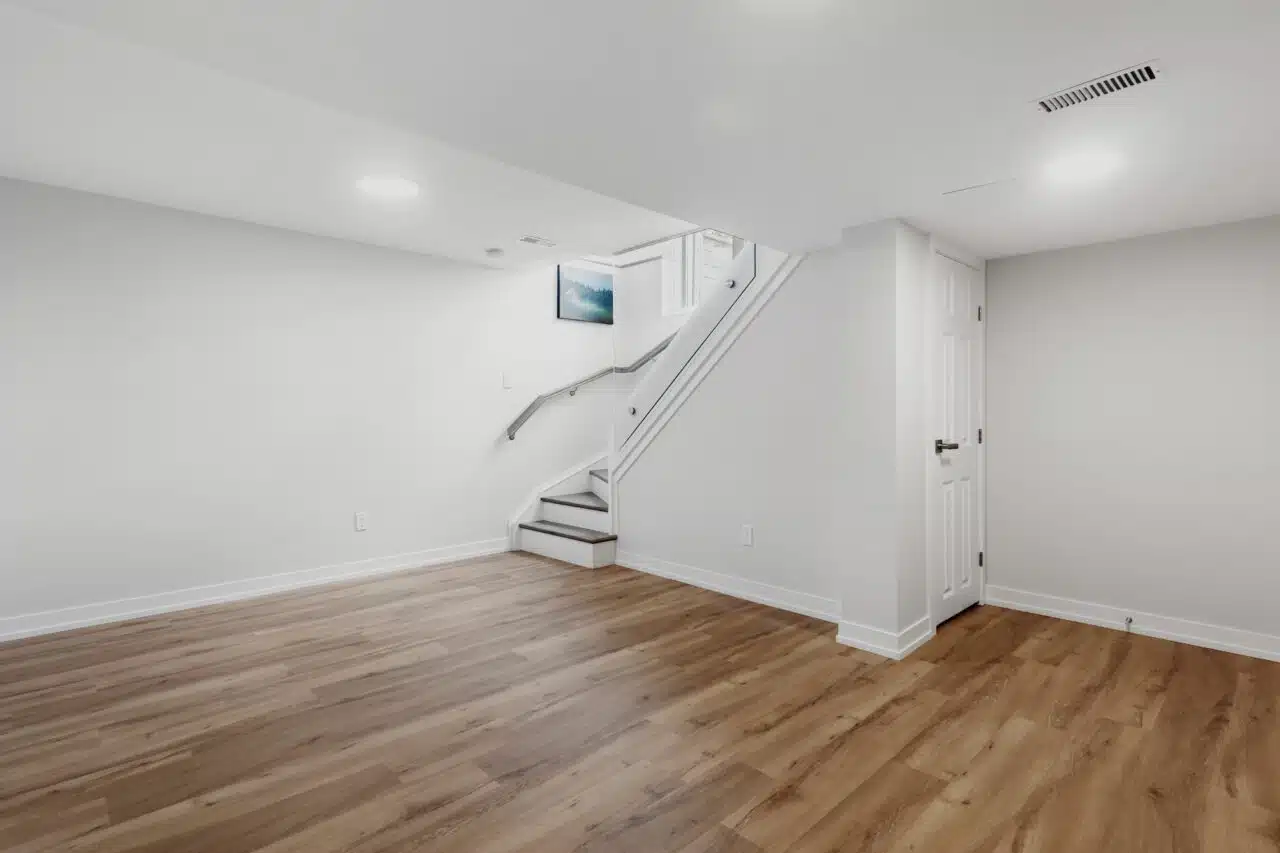If you’re a homeowner in Canada, you know how essential it is to protect your basement from water damage. In this blog, we will explore various basement waterproofing methods that can help you prevent costly and disruptive water issues. Whether you’re dealing with a leaky basement or want to proactively safeguard your home, understanding these methods will empower you to make informed decisions about keeping your basement dry and secure.
Types of Basement Waterproofing Methods
1. Exterior Waterproofing
One of the most common basement waterproofing methods is installing a system outside. This method, which is also known as “positive-side waterproofing,” employs a watertight membrane or coating to seal off the basement from the outside. Some services call it Excavation And Waterproofing Membrane Installation.
Plastic sheets and/or a thin coating of bentonite clay are used to provide a waterproof barrier in the membrane treatment. Most external methods for waterproofing a basement have a coating that may be applied by brush or spray and has the consistency of thick tar.
Exterior waterproofing is one of the basement waterproofing methods that is best done at the beginning of the building process because it can get expensive. Otherwise, the exterior of an existing building must be excavated completely around the base before a waterproof coating or membrane can be installed. Professional excavation employing powerful earth-moving machinery often comes at a high cost. The cost of a waterproof coating and the price of backfilling the foundation is added to this.
The price of a foundation’s excavation and waterproofing depends on several variables.
- In comparison to using an excavator, the cost of excavating by hand is far higher;
- The expense of excavating by hand under a deck is high and depends on factors including the length of the excavation, its depth, and its placement.
- A significant extra expense is incurred when a corridor dig is required (in which earth is moved to the front or back of the house by wheelbarrow or with a skid steer (Bobcat) since there is no room to deposit the soil near the excavated area);
- Additional expenses may be incurred due to the requirement to cut and/or remove and dispose of poured concrete or asphalt that covers the area to be excavated.
- Finally, fixing up the yard after the waterproofing is done is another factor.
2. French Drain Basement Waterproofing
To keep water away from a basement’s foundation, a French drain can be installed in the ground and connected to a sump pump or gravity. This is also one of the easiest-to-understand types of basement waterproofing methods.
A French drain is an excellent method for waterproofing a basement because it prevents water from pooling in the ground around the house’s foundation. Rather than keeping water at bay, your basement remains dry because the water never enters it. A French drain is installed to divert the water away from the base.
There are two types of French drain waterproofing: Exterior and interior.
Waterproofing the basement by installing exterior French drains is a common practice. This method of outside waterproofing involves excavation down to the footer, making its installation in an existing home a substantial construction effort.
Meanwhile, interior French drains involve digging out the basement floor and building the drains from the inside to keep water out. Excess water is directed into a sump pit and then discharged away from the foundation, preventing hydrostatic pressure from building up in the soil beneath it.
French drain basement waterproofing is not something you should try to perform on your own. If you want an external French drain, you’ll need to dig down to the footer, and if you want one in your basement, you’ll need to use a jackhammer to tear up the floor. It’s best to have trained Alliston basement waterproofing experts to handle this.
One big downside is that only water that is directly below the basement floor can be drained using an interior French drain. Water will still be able to infiltrate through any holes or crevices in the basement’s walls. Additionally, when digging the trench for a French drain with a backhoe, it may be necessary to remove pre-existing structures like decks and walkways. Clogged weeping tile can be quite expensive to fix as it may require extensive excavation.
3. Interior Weeping Tile System
The alternative to foundation excavation basement waterproofing methods, often for a concrete block foundation, is an interior weeping tile system (also known as an internal perimeter drain system).
An interior weeping tile system is one of the most tried and true ways of basement waterproofing methods, a basement without breaking the bank as it requires no excavation. Waterproofing concrete blocks or cinder block foundation walls is the primary function of interior perimeter drainage systems. Some large corporations promote this form of the waterproofing system as an effective solution to any and all foundation water issues because of how reliable it is. Given the damaging nature of foundation excavation, internal waterproofing is often the preferred method.
On the other hand, the perforated pipe used in an exterior drain tile system is laid at the footer level all the way around the foundation of the house. An outside drain tile system is standard in today’s new construction. However, they can also be retrofitted into preexisting houses, albeit at a significant cost and effort.
To install an outside drain tile system in an existing house, first, the footer must be excavated, then a trench must be dug alongside the footer, and finally, a sump pit must be dug if one is to be installed. After placing the perforated pipe in the trench, gravel and a specific, porous cloth are used to prevent soil from entering the pipe. The last step is to backfill the excavation and cover the pipe with soil. Gravity will carry away any remaining water in the soil, and a sump pit and pump will remove any remaining water from the area around the foundation.
Basement waterproofing technologies such as internal drain tile systems and outside drain tile systems are both effective yet labor-intensive. Don’t try to take on this task by yourself.
4. Sump Pump Basement Waterproofing
If you want to avoid flooding in the basement, you need a sump pump. This is especially essential If your area frequently floods. By pumping water out of the basement and away from the house’s foundation, a sump pump can help keep water issues to a minimum.
Most sump pumps require power to function. The two most common types are submersible pumps and pedestal pumps.
Located at the base of the tank, submersible pumps are completely submerged in the water. The flat screen or grate at its base prevents trash from entering the gadget through the pipe that leads outside. The grating at the bottom acts as a drain, directing water or moisture to the outlet.
Pumps that sit atop tall poles are called pedestal pumps. The pedestal raises the pumping apparatus out of the water. The intake line extends into the tank and pulls water out of the sump pit when it fills up. Although the cost savings are normally appreciated, the motor and pump noise is often amplified when installed on land.
It’s not enough to just install a pump; regular maintenance is essential if you want to avoid having to question your need for water restoration. There may be an issue with the pump’s reliability if you notice it making noises or if you’re getting more notifications than usual. If you take care of it, it will last a lot longer.
Problems with mold and mildew might develop if your property retains too much moisture due to a malfunctioning sump pump.
You probably already know this if you have a dirty, open sump pit and an under-powered sump pump that has led to basement flooding in the past, such as when the pump’s intake gets clogged with debris and sediment in the sump pit when the switch fails, or when the pump burns out at the worst possible time.
Factors to Consider When Choosing a Waterproofing Method
1. Prone Areas of Water Leakage
If you suspect water damage in the basement, you should investigate possible entry points. You can tell if there’s water damage by looking for damp spots, mould, or anything white. If the walls and ceiling of the basement have been painted, look for evidence of peeling paint, cracks, and water damage.
Do not dismiss musty odours or the appearance of mould. It’s a good idea to check for mould under any rugs or carpets by lifting them up. If any of these conditions apply to you, it’s time to get to work fixing your water situation. Large losses can be avoided if these issues are discovered sooner rather than later.
You can ask your Alliston basement waterproofing plumber what type of waterproofing method is best for your basement based on its current needs.
Every basement waterproofing job is different, therefore the method used to fix your issue must be tailored to your specific needs. DIY projects or hiring a cheap contractor may seem like a good way to save money in the short term, but a shoddy or insufficient repair could end up costing you thousands.
2. Interior Waterproofing vs Exterior Waterproofing
Take a look at the area you’ll be working in before deciding whether to install interior or exterior waterproofing. You should look inward for a solution if your basement is unfinished and serves mostly as a storage area. If you’ve spent years cultivating lovely landscaping around your home’s outside, it’s probably best to find a remedy inside as well. The selection will be more challenging if you have a finished basement and a nice landscape outdoors.
3. Plan For The Future
Considering your future plans for the basement might help you decide on the best waterproofing strategy to employ.
How much of this space do you plan to complete? Was it completed before the water damage occurred? Will you replace it, improve it, or do away with it entirely if this is the case? When did you first move into this house? Do you hope to stay put for the foreseeable future or are you seriously considering a move?
If you want to waterproof your basement but don’t have a severe water problem right now, these questions can help you narrow down your options. Keep in mind that if you cover the bare concrete, you could not notice a leak until it has ruined your finishes.
4. Repair Now Or Wait?
While it’s true that minor waterproofing concerns probably won’t break the bank, putting off servicing on even the simplest water problems could end up costing you more in the long run.
Basement finishes might be ruined if they conceal water seepage. Mould and mildew may spread quickly through a home, ruining the furnishings, carpets, and flooring. Damaged foundations may invite pests like termites. These are some of the factors that you have to consider should you decide to wait.
Not to mention, mould can quickly spread throughout a home and pose a significant health risk to anybody living there. Skin rash, itchy eyes, a runny nose, coughing, sneezing, and respiratory problems are just a few of the frequent manifestations of an allergic reaction. More severe health problems may emerge after prolonged exposure.
The longer you put it off, the more likely it is that your basement will flood and all of your belongings will be destroyed. Delaying the project until you have saved enough money to pay for it could take more time than you anticipate. To avoid putting off the essential repairs any longer, talk about financing possibilities with your contractor.
5. Cost
It is crucial to be aware of the expenses associated with any potential choices because money plays a significant role in the decision-making process. Some waterproofing is typically less expensive than others, while it is impossible to give an exact price due to the wide variety of feasible projects.
If you live in a region with above-average humidity and can afford a more expensive waterproofing method, you should strongly consider installing membrane-sealed tanking in your basement. In the long term, the cost of repairs will increase enormously if you don’t have the right system in place for your property’s needs.
Hiring a Professional Waterproofing Contractor in Alliston
Hiring a professional contractor is essential to the efficiency and longevity of a basement waterproofing project. Professional waterproofing services in Alliston have the training and experience to determine the best waterproofing solution for your basement and to implement it successfully.
You may rest easy knowing the task will be done right and in accordance with all applicable norms and codes if you hire a dependable contractor. In addition, experts can advise you on how to best care for your basement to ensure that it remains dry and secure for years to come. If you want to make sure your basement is dry and free from flooding, you should talk to a professional waterproofing contractor.


